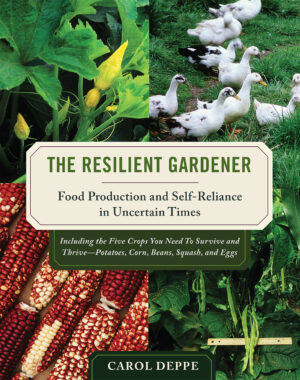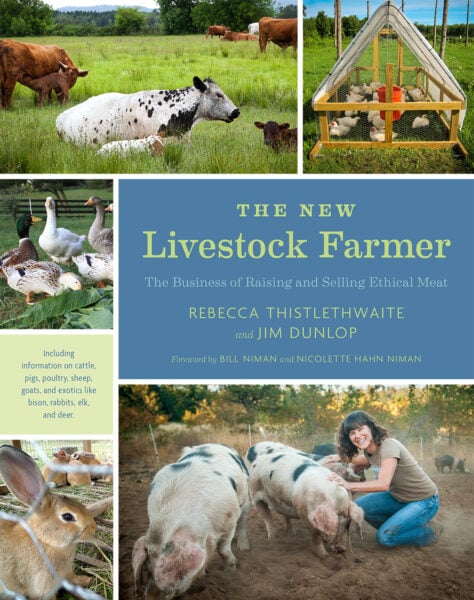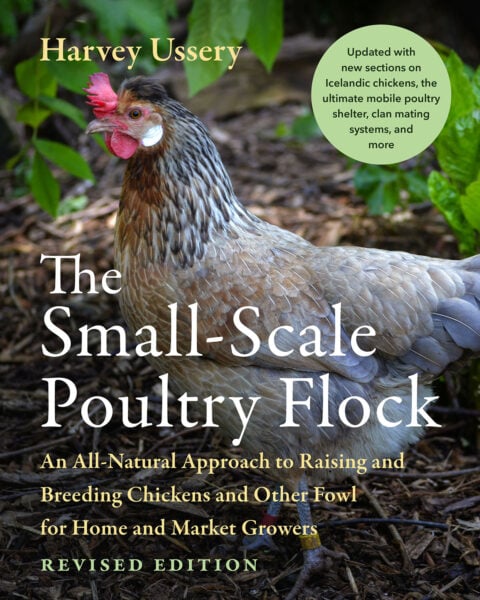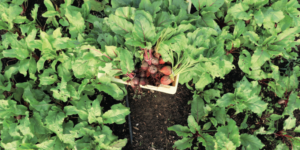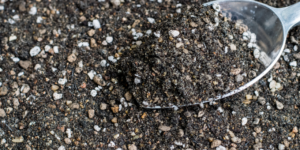Are you Team Duck or Team Chicken?
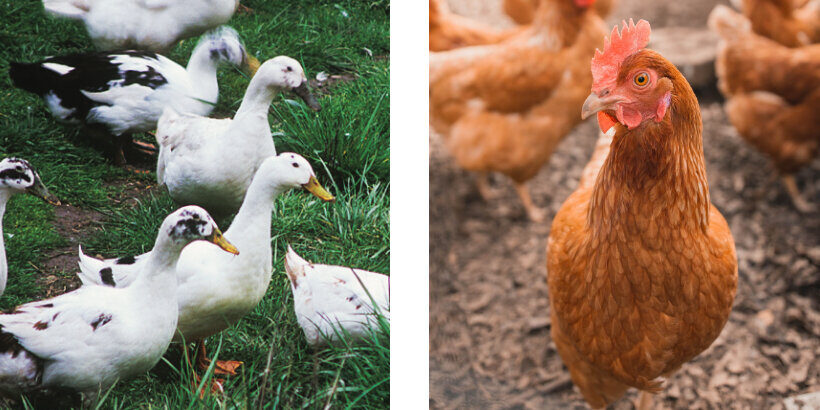
Thinking about adding a laying flock to your backyard, but having trouble deciding between ducks and chickens? Agonize no more.
Ducks are easy to herd, have routine egg laying hours, and are superior to chickens in terms of pest control. Chickens are more readily available, usually cheaper to purchase, and are a better confinement animal, which is an important factor if space is an issue. Now, are you team duck or team chicken?
The following is an excerpt from The Resilient Gardener by Carol Deppe. It has been adapted for the web.
The most ecologically well-adapted livestock for the maritime Northwest is the duck. The best-laying duck breeds lay better than the best-laying chicken breeds. Ducks can free-range year-round in our region. Ducks forage much more of their diets than chickens and eat a larger variety of natural foods common here. Ducks eat snails and slugs, and are better for yard and garden pest control. Ducks love our weather. (I should perhaps mention my biases. I’ve kept five breeds of chickens, two breeds of geese, and seven breeds of ducks. The ducks are my favorites, especially Ancona ducks, and at this point, I keep only a flock of thirty-two Ancona ducks. But I like chickens too.)
Eggs
Many people who are allergic to chicken eggs can eat duck eggs. A few people are allergic to both. I have also run into occasional people who claim to have problems eating duck eggs who can eat chicken eggs, though this pattern seems to be rare. Ducks from the better-laying breeds and strains can lay well enough to earn their keep for years. Laying chickens are usually not producing economically beyond the second year.
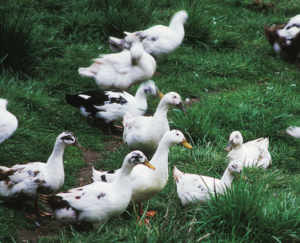 Ducks are much easier to control than chickens. Ducks of laying breeds can be easily confined with a fence only 2 feet high (as long as they have food and water and their buddies with them). Most of the egg breeds of chickens can fly well enough to get over any fencing. Keeping them out of the garden or the eaves of the porch often requires wing-clipping every bird.
Ducks are much easier to control than chickens. Ducks of laying breeds can be easily confined with a fence only 2 feet high (as long as they have food and water and their buddies with them). Most of the egg breeds of chickens can fly well enough to get over any fencing. Keeping them out of the garden or the eaves of the porch often requires wing-clipping every bird.
Ducks tend to lay eggs that are bigger than chicken eggs from a breed of equivalent size. Some dual-purpose duck breeds (such as Anconas) lay eggs that are very big for the size of the bird.
Ducks normally lay their eggs between 4:00 a.m. and 8:00 a.m. daily. This means they lay their eggs in the nests in their night pens instead of hiding a nest in the yard. You can pick up the duck eggs just once per day, at the same time that you let the ducks out to forage. Chickens have a twenty-six-hour laying cycle, meaning each hen lays a little later each day. So a flock of chickens is laying at all times of the day and night. When allowed to free-range, they sometimes come back to lay in their nests and sometimes don’t. So recovering all the eggs can be problematic.
Pest Control
Chickens can help with pest control in yards, gardens, and pastures under certain circumstances. But chickens don’t eat big slugs or snails, two of the most important garden pests in the Northwest. (Some chickens may eat small slugs or snails.) And the scratching of chickens tears up plantings and scatters manure and dirt over the rest. Ducks are considered the premier critter for pest control. All the laying breeds of ducks are big enough to eat even 8-inch banana slugs, and do so with enthusiasm, swallowing them the way a sword swallower does a sword.
Moving Your Ducks and Chickens Around
Ducks are easy to herd. You can use one or two herding staffs, or you can just walk behind the ducks with your hands extended sideways, making scooping motions in the direction you want the ducks to go and saying, “Let’s go, ducks.”
In Asia, the free-range egg industry is based upon ducks that are kept in secure permanent quarters at night and herded to various separate foraging areas during the day. Since chickens can’t be herded, the night pen or house usually needs to be in or adjacent to the foraging area. To rotate chicken forage, you move their house, which must be portable. To rotate duck forage, you just herd the ducks to a different spot during the day, leaving their permanent pen in its permanent spot.
The crowing of roosters is much louder than any noise ducks make. Neighbors are less likely to hear or object to the sounds of ducks.
Climate Considerations
In many areas free-range chicken eggs are only seasonal, but free-range duck eggs are year-round. Here in the maritime Northwest, the free-range duck is happy foraging outdoors the entire year, and ducks of appropriate breeds are good winter layers. Ducks delight in cold rain. Chickens are so miserable in cold rain and use so much energy keeping warm that they either don’t lay or their egg production isn’t economical. The duck is the only way to get economical, year-round, free-range egg production in the maritime Northwest and other areas with cold, wet winters. (In areas where the ground is frozen much of the winter, there is no way to get winter free-range egg production from any poultry.)
Diet
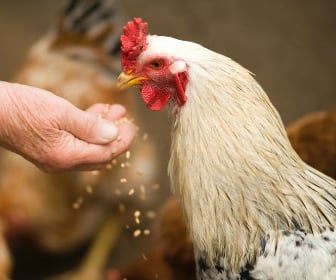 Ducks can forage a larger part of their diet than chickens. Chickens eat mostly grain and animal life, with greenery as a salad. Ducks eat grain and animal life but also considerably more greenery than chickens, including grass, as long as it is succulent and growing.
Ducks can forage a larger part of their diet than chickens. Chickens eat mostly grain and animal life, with greenery as a salad. Ducks eat grain and animal life but also considerably more greenery than chickens, including grass, as long as it is succulent and growing.
In addition, ducks can make excellent use of wetlands, waterways, lakes, and ponds.
Ducks are more resistant to disease than chickens. Ducklings are hardier than chicks. Ducklings are more heavily feathered and have a layer of subcutaneous fat. They are designed for cold, wet weather. Ducklings can be outdoors earlier in spring than chicks. If allowed to waterproof themselves properly, ducklings can be out foraging in their third week. Chicks are normally kept indoors the first six to eight weeks.
Ducks, however, are much more vulnerable to four-footed predators than chickens, especially chickens with intact wings. Some people with marginal fencing or night housing can keep chickens but not ducks.
Chickens are much more readily available and usually cheaper. Day-old chicks of many breeds are often sold sexed, so you can get exactly as many of each sex as you want. Most laying breeds of ducks are much less available and are usually sold as straight-run only, meaning you don’t know how many of what sex you’re getting.
Water
Ducks need bathing water. Chickens maintain their skin and feather condition via dust bathing. Some people find it much easier to provide a dry dust bath than a bathing pool. Books sometimes say ducks can be raised without bathing water. Although this is technically true, raising ducks that way isn’t kind. Ducks keep their skin and feathers in condition by bathing in water and preening and coating their feathers with wax. All you need for a handful of ducks is a kiddy pool of water changed a couple of times a week. My ducks have a small pond I made by propping up a piece of pond liner on the hillside so I can open one side and drain it and hose it down easily. If you are unwilling to provide bathing water for ducks, I suggest you get chickens.
Chickens are a much better confinement animal than ducks. Ducks drink far more water, have a much looser, more liquidy poop, and need more space when confined than chickens. Some people need to confine their poultry and bring the garden produce and food to the birds. Chickens are usually the better choice for that situation.
In areas where winter is harsh and the ground is frozen or covered with snow for months, any poultry has to be confined. This fact can translate into chickens being the most workable option. If I lived in Minnesota or Wisconsin, or upstate New York, I think I would keep chickens instead of ducks.
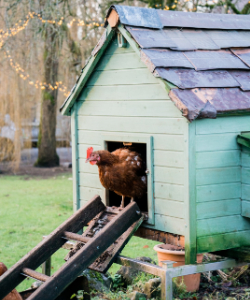 Don’t Put Ducks in a “Chicken Tractor”
Don’t Put Ducks in a “Chicken Tractor”
The “chicken tractor” is a small portable house with no floor that is moved around to fresh ground every day or so. There are many books and articles about this style of poultry keeping. It is actually a confinement situation in which the birds get a little greenery but not actually very much animal material. It works best for commercial broiler chickens, which don’t forage very actively or move far from the feeders anyway.
Laying hens in chicken tractors produce eggs that are more a commercial-diet-based egg than a free-range one. However, chicken tractors are the only option many people have for their laying flock, and the chicken tractor, managed optimally, produces eggs that are better tasting, probably more nutritious, and certainly more ethical than those from commercial caged layers.
Chicken tractors work best with chickens. You can’t just substitute ducks. Laying chickens roost on raised perches at night and will use nests stacked in a bank against the wall. So the chickens use three dimensions of the space in a small movable house. The “chicken tractor” usually has one wall of nests that can be accessed from the side without entering the pen and a built-in roost on one side or end. A chicken tractor for ducks is problematic.
Ducks use only floor space, and so need much more floor space than chickens, even before taking into account that their manure is much wetter. They need extra floor space for nests and resting. They need much more water and bigger water containers and bathing water. By the time you have given the ducks a big enough pen to be comfortable for them, it won’t be able to hold many birds in it, and it will not be very portable.
In America and Europe, chicken eggs are the standard. Most people don’t know how to cook duck eggs. During the last two decades, I’ve developed cooking methods and recipes for an American style of duck egg cookery. If you sell duck eggs, you will need to do some customer education on how they should be cooked.
Many people will enjoy trying both chickens and ducks. Generally, the two species should not be brooded together or housed in the same night quarters (unless they’re in separate pens). They have different requirements. However, chickens and ducks can usually share their daytime foraging area.
Recommended Reads
Recent Articles
Picture-perfect farms may be aesthetically pleasing, but they’re likely lacking in biodiversity. Rewilding practices allow the land to return to its natural wild state, providing more room for fruit-bearing plants to grow and animals to control small pests. The following is an excerpt from Farming on the Wild Side by Nancy J. Hayden and John…
Read MoreLet’s drop the beet! Beets can be grown year-round and are a perfect, flavorful addition to meals. Get started on growing your own no-till beets with help from these tips! The following is an excerpt from The Living Soil Handbook by Jesse Frost. It has a been adapted for the web. How to Grow No-Till…
Read MoreHow do you control bugs & pests on your fruit trees without using harmful sprays and treatments? Here are some tips for identifying insects on fruit trees and controlling them organically. The following is an excerpt from The Holistic Orchard by Michael Phillips. It has been adapted for the web. Finding Insects On Fruit Trees…
Read MoreLooking for ways to naturally enrich your garden? The answer is all around you….literally. Add local rocks & soil to your garden to improve soil health and see your crops flourishing in no time. The following is an excerpt from The Regenerative Grower’s Guide to Garden Amendments by Nigel Palmer. It has been adapted for the…
Read MoreGarden strawberries are excellent for both covering the ground and for growing fruit. If you’re planning out a forest garden, or are just looking for a plant to use as ground cover, strawberries are a great option. The following is an excerpt from The Home-Scale Forest Garden by Dani Baker. It has been adapted for…
Read More

